
This article includes two versions of the list of countries by crude birth rate.

This article includes two versions of the list of countries by crude birth rate.
Crude birth rate refers to the number of births over a given period divided by the person-years lived by the population over that period.
It is expressed as number of births per 1,000 population.
The article lists 233 countries and territories in crude birth rate.
The first list is provided by Population Reference Bureau. [1]
The second list is based on CIA World Factbook estimates for the year 2023. [2]
Dependent territories and not fully recognized states might not be ranked.
| Country/territory | PRB 2022 [1] | CIA WF 2023 [2] |
|---|---|---|
| 36 | 34.79 | |
| 10 | 12.48 | |
| 22 | 17.84 | |
| 6 | 6.87 | |
| 39 | 41.42 | |
| 12 | 15.01 | |
| 14 | 15.38 | |
| 12 | 10.80 | |
| 12 | 12.23 | |
| 10 | 9.39 | |
| 13 | 13.20 | |
| 11 | 14.49 | |
| 12 | 12.30 | |
| 18 | 17.50 | |
| 8 | 10.73 | |
| 9 | 8.87 | |
| 10 | 10.86 | |
| 17 | 20.93 | |
| 36 | 40.72 | |
| 14 | 15.61 | |
| 22 | 18.08 | |
| 7 | 8.31 | |
| 24 | 19.95 | |
| 11 | 10.67 | |
| 14 | 15.98 | |
| 9 | 7.97 | |
| 35 | 32.71 | |
| 35 | 34.87 | |
| 22 | 18.75 | |
| 35 | 35.13 | |
| 10 | 10.11 | |
| 15 | 18.19 | |
| 43 | 32.37 | |
| 43 | 39.85 | |
| 11 | 12.57 | |
| 7 | 9.7 | |
| 15 | 15.06 | |
| 29 | 22.06 | |
| 42 | 39.64 | |
| 31 | 31.55 | |
| 11 | 14.03 | |
| 34 | 27.92 | |
| 9 | 8.60 | |
| 9 | 9.99 | |
| 10 | 10.37 | |
| 11 | 8.43 | |
| 11 | 11.25 | |
| 22 | 22.03 | |
| 13 | 13.64 | |
| 18 | 17.80 | |
| 17 | 16.19 | |
| 21 | 20.48 | |
| 16 | 17.49 | |
| 30 | 29.46 | |
| 29 | 26.72 | |
| 9 | 8.48 | |
| 24 | 22.83 | |
| 32 | 29.97 | |
| 19 | 16.25 | |
| 9 | 10.33 | |
| 11 | 11.56 | |
| 27 | 25.89 | |
| 33 | 28.03 | |
| 12 | 10.79 | |
| 10 | 9.02 | |
| 28 | 28.04 | |
| 8 | 7.52 | |
| 16 | 13.61 | |
| 21 | 21.88 | |
| 34 | 35.47 | |
| 31 | 36.25 | |
| 20 | 16.74 | |
| 23 | 20.81 | |
| 21 | 17.64 | |
| 9 | 8.58 | |
| 13 | 12.80 | |
| 20 | 16.53 | |
| 16 | 15.05 | |
| 14 | 14.79 | |
| 27 | 24.22 | |
| 12 | 12.08 | |
| 20 | 17.30 | |
| 7 | 7.00 | |
| 12 | 15.77 | |
| 7 | 6.90 | |
| 18 | 22.37 | |
| 23 | 14.92 | |
| 28 | 26.01 | |
| 27 | 19.92 | |
| 13 | 14.06 | |
| 5 | 6.95 | |
| 12 | 17.65 | |
| 24 | 19.08 | |
| 21 | 20.35 | |
| 9 | 8.50 | |
| 15 | 12.86 | |
| 26 | 23.01 | |
| 31 | 36.26 | |
| 17 | 20.88 | |
| 9 | 10.30 | |
| 9 | 9.09 | |
| 10 | 11.59 | |
| 35 | 28.14 | |
| 33 | 27.29 | |
| 14 | 14.39 | |
| 13 | 15.33 | |
| 42 | 40.54 | |
| 9 | 9.59 | |
| 19 | 21.61 | |
| 39 | 27.61 | |
| 10 | 9.82 | |
| 15 | 13.95 | |
| 18.12 | ||
| 11 | 9.94 | |
| 25 | 6.61 | |
| 22 | 15.37 | |
| 11 | 11.04 | |
| 17 | 17.10 | |
| 37 | 36.94 | |
| 17 | 16.04 | |
| 27 | 24.68 | |
| 28 | 20.71 | |
| 20 | 17.26 | |
| 10 | 10.98 | |
| 11 | 12.69 | |
| 19 | 16.30 | |
| 45 | 46.86 | |
| 37 | 34.00 | |
| 10.33 | ||
| 10 | 11.89 | |
| 19 | 21.62 | |
| 28 | 26.01 | |
| 15 | 11.57 | |
| 29 | ||
| 15 | 17.71 | |
| 26 | 28.54 | |
| 21 | 16.15 | |
| 17 | 16.96 | |
| 22 | 22.17 | |
| 9 | 8.31 | |
| 8 | 7.99 | |
| 10 | 9.27 | |
| 9 | 8.63 | |
| 10 | 9.22 | |
| 30 | 25.70 | |
| 12.06 | ||
| 12 | 11.73 | |
| 12.09 | ||
| 29 | 19.03 | |
| 6 | 8.88 | |
| 28 | 27.43 | |
| 17 | 13.90 | |
| 32 | 30.84 | |
| 9 | 8.87 | |
| 17 | 12.10 | |
| 33 | 31.49 | |
| 9 | 8.94 | |
| 10 | 8.78 | |
| 9 | 8.12 | |
| 30 | 22.34 | |
| 44 | 37.71 | |
| 20 | 18.24 | |
| 29 | 37.07 | |
| 7 | 7.12 | |
| 13 | 13.61 | |
| 34 | 33.32 | |
| 17 | 15.17 | |
| 11 | 10.76 | |
| 10 | 10.30 | |
| 20 | 22.19 | |
| 7 | 7.33 | |
| 27 | 20.28 | |
| 36 | 32.90 | |
| 10 | 10.04 | |
| 25 | 30.36 | |
| 32 | 31.39 | |
| 23 | 20.02 | |
| 11 | 10.62 | |
| 16 | 14.05 | |
| 13 | 14.04 | |
| 22 | 17.16 | |
| 25 | 22.34 | |
| 37 | 40.27 | |
| 7 | 8.79 | |
| 10 | 10.76 | |
| 10 | 10.80 | |
| 11 | 12.21 | |
| 10 | 12.65 | |
| 26 | 15.18 | |
| 29 | 21.19 | |
| 16 | 16.99 | |
| 15 | 15.29 | |
| 17 | ||
| 30 | 24.05 | |
| 34 | 34.48 | |
| 31 | 32.77 | |
| 11.90 | ||
| 11.69 | ||
| 10.97 | ||
| 10.90 | ||
| 11.62 | ||
| 9.73 | ||
| 12.31 | ||
| 12.34 | ||
| 13.07 | ||
| 14.94 | ||
| 13.84 | ||
| 13.66 | ||
| 11 | ||
| 17 | 18.33 | |
| 27 | ||
| 7.85 | ||
| 10.49 | ||
| 15 | 14.57 | |
| 8.82 | ||
| 10 | ||
| 34 | ||
| 10.66 | ||
| 14 | 13.96 | |
| 15.60 | ||
| 13 | 13.22 | |
| 6 | 7.84 | |
| 16 | ||
| 9.30 | ||
| 9.33 | ||
| 13.95 | ||
| 6.54 | ||
| 16.18 | ||
| 12.41 | ||
| 13.24 | ||
| 11.35 | ||
| 12.05 | ||
| 27.20 | ||
| World (2020) | 18.10 |
Note: There is no data for Christmas Island (Australia), Cocos (Keeling) Islands (Australia), Falkland Islands (UK), Niue (New Zealand), Norfolk Island (Australia), Pitcairn Islands (UK), Svalbard (Norway), Tokelau (New Zealand) and Vatican City.
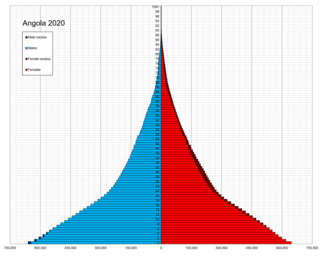
Demographic features of the population of Angola include population density, ethnicity, education level, health of the populace, economic status, religious affiliations and other aspects.

Demographic features of the population of Cambodia include population density, ethnicity, education level, health of the populace, economic status, religious affiliations and other aspects of the population.
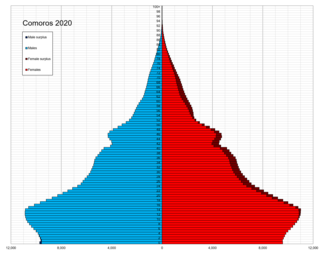
The Comorians inhabiting Grande Comore, Anjouan, and Mohéli share African-Arab origins. Islam is the dominant religion, and Quranic schools for children reinforce its influence. Although Islamic culture is firmly established throughout, a small minority are Christian.

The demographics of Ethiopia encompass the demographic features of inhabitants in Ethiopia, including ethnicity, languages, population density, education level, health, economic status, religious affiliations and other aspects of the population.

The population of Indonesia was 270.20 million according to the 2020 national census, an increase from 237.64 million in 2010. The official estimate as at mid 2022 was 275,773,800, increasing at a rate of 1.17% per year. Indonesia is the fourth most populous country in the world. Approximately 55% of Indonesia's population resides on Java, which is the most populous island in the world.
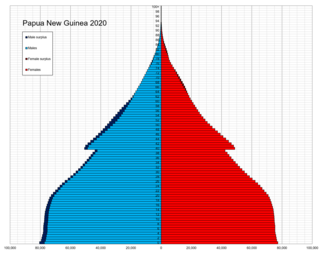
The indigenous population of Papua New Guinea is one of the most heterogeneous in the world. Papua New Guinea has several thousand separate communities, most with only a few hundred people. Divided by language, customs, and tradition, some of these communities have engaged in endemic warfare with their neighbors for centuries. It is the second most populous nation in Oceania, with a total population estimated variously as being between 9.5 and 10.1 million inhabitants.
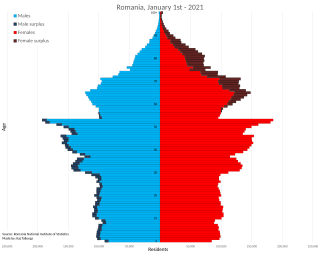
Demographic features of the population of Romania include population density, ethnicity, education level, health of the populace, economic status, religious affiliations, and other aspects of the population.

Demographic features of the population of Samoa include population density, ethnicity, education level, health of the populace, economic status, religious affiliations and other aspects of the population.

Demographic features of the population of Tuvalu include the age structure, ethnicity, education level, life expectancy, religious affiliations and other aspects of the population.
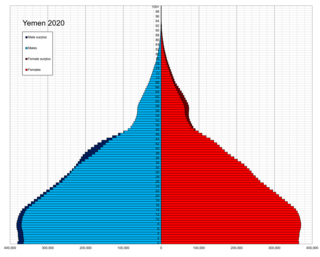
Demographic features of the population of Yemen include population density, ethnicity, education level, health of the populace, economic status, religious affiliations and other aspects of the population.
Death rates in the 20th century is the ratio of deaths compared to the population around the world throughout the 20th century. When giving these ratios, they are most commonly expressed by number of deaths per 1,000 people per year. Many factors contribute to death rates such as cause of death, increasing the death rate, an ageing population, which could increase and decrease the death rates by birth rates, and improvements in public health, decreasing the death rate.

The population of Australia is estimated to be 27,218,100 as of 29 May 2024. Australia is the 56th most populous country in the world and the most populous Oceanian country. Its population is concentrated mainly in urban areas, particularly on the Eastern, South Eastern and Southern seaboards, and is expected to exceed 30 million by 2029.

This is a demography of the population of Azerbaijan including population density, ethnicity, education level, health of the populace, economic status, religious affiliations and other aspects of the population.

Mortality rate, or death rate, is a measure of the number of deaths in a particular population, scaled to the size of that population, per unit of time. Mortality rate is typically expressed in units of deaths per 1,000 individuals per year; thus, a mortality rate of 9.5 in a population of 1,000 would mean 9.5 deaths per year in that entire population, or 0.95% out of the total. It is distinct from "morbidity", which is either the prevalence or incidence of a disease, and also from the incidence rate.

Birth rate, also known as natality, is the total number of live human births per 1,000 population for a given period divided by the length of the period in years. The number of live births is normally taken from a universal registration system for births; population counts from a census, and estimation through specialized demographic techniques. The birth rate is used to calculate population growth. The estimated average population may be taken as the mid-year population.
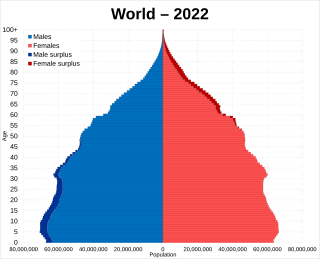
Earth has a human population of over 8 billion as of 2024, with an overall population density of 50 people per km2. Nearly 60% of the world's population lives in Asia, with almost 2.8 billion in the countries of China and India combined. The percentage shares of China, India and rest of South Asia of the world population have remained at similar levels for the last few thousand years of recorded history. The world's literacy rate has increased dramatically in the last 40 years, from 66.7% in 1979 to 86.3% today. Lower literacy levels are mostly attributable to poverty. Lower literacy rates are found mostly in South Asia and Sub-Saharan Africa.